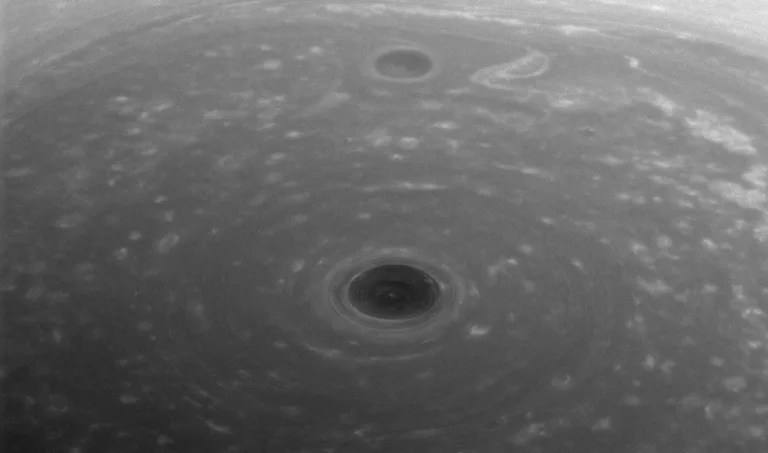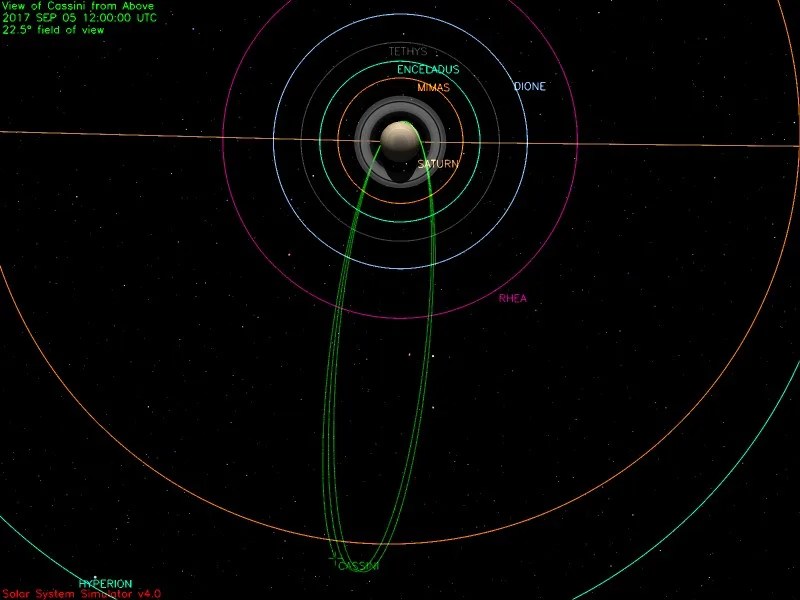8 min read

With less than two weeks (and one more complete orbit) to go, Cassini spent its time this week investigating the planet's ring system as it interacts with the moons, studying the magnetosphere as it interacts with the Sun and the planet, and examining Saturn's moons themselves. As it has for the past three weeks, Cassini investigated the gas giant itself by dipping in to its uppermost atmosphere, gathering, examining, and reporting on its constituents. Cassini is doing exceptionally well with these daring plunges. The credit is shared between the accurate predictions by the flight team's navigators, planners and scientists, the ongoing care from the spacecraft engineers and operators, and Cassini’s exceptional control system.
Wednesday, Aug. 30 (DOY 242)
The Cassini spacecraft reached apoapsis early today. At the time, it was in routine communications with the Cassini Flight Team via the Deep Space Network (DSN). Cassini kept its high-gain antenna dish tracking the Earth for nine hours, while the DSN made its accurate tracking measurements; Cassini's line-of-sight velocity and distance are all the Navigation Team need for precise determination of the spacecraft’s fight path. Routine commands finished propagating at the speed of light and were stored aboard the spacecraft, and were acknowledged. Telemetry (the digital data) propagated to Earth for the whole period; the one-way light time was 81 minutes. Included in the telemetry were the bits representing results of science observations, along with thousands of measurements of the spacecraft's temperature, computer states, power levels, pressures, and the like, which report the health of the spacecraft and every instrument. This week, due to the great performance of the DSN, not a single bit of data was lost.
Following apoapsis passage, which marked the start of Orbit #291, the Imaging Science Subsystem (ISS) turned to Saturn's largest moon for 90 minutes to carry out a Titan monitoring observation. As usual, the Visible and Infrared Mapping Spectrometer (VIMS) and the Composite Infrared Spectrometer (CIRS) rode along making their own observations. This was repeated on the following day, and then again on Friday.
Next, CIRS turned to Saturn for nearly 11 hours. With ISS, VIMS, and the Ultraviolet Imaging Spectrograph (UVIS) riding along, it measured upper-troposphere and tropopause temperatures using mid-infrared wavelengths, while Saturn rotated on its axis through approximately one full Saturn day.
A clever poster was published today showing Cassini's accomplishments in a unique graphic form: /resources/17757.
Thursday, Aug. 31 (DOY 243)
When it was CIRS's turn today, the instrument led a 9.4-hour observation to study the composition of Saturn’s atmosphere, with the whole set of other Optical Remote-Sensing (ORS) instruments riding along. Together, they covered the spectrum from ultraviolet wavelengths through the visible, and down into the deep thermal infrared.
Friday, Sept. 1 (DOY 244)
Today was a day to watch Saturn. UVIS, VIMS and CIRS, looked "down" on the planet's illuminated north-polar auroral zone for a total observing time of 11 hours. Their viewing geometry is simulated here: https://go.nasa.gov/2eGzf1c . In the final seconds of the day, CIRS began two hours of "alone time" with the huge planet to characterize the particular spot in Saturn's rotating atmosphere through which a stellar occultation would occur several hours later.
Saturday, Sept. 2 (DOY 245)
Taking the reins, UVIS led CIRS and VIMS in observing Saturn's limb for 6.7 hours, to study the planet's upper atmosphere, which later in the day will be in Cassini's face again, when the spacecraft's direct-sensing instruments will be sampling its constituents.
Next, the stellar occultations began, while Cassini was on "final approach" to today's periapsis passage. Thanks to Cassini's motion in orbit, VIMS watched the bright red star Gamma Crucis as it passed behind the rings, and then the planet itself; CIRS rode along. The resulting measurements will help determine the helium to hydrogen ratio in Saturn's lower stratosphere.
Still gaining speed near the end of its million-mile dive, Cassini transitioned its attitude control to thrusters once again. The little hydrazine-fed rockets, which are mounted out on struts, provide enough control authority to manage these high-velocity brushes with Saturn's thin upper atmosphere. During the two hours surrounding ring-plane crossing and periapsis, the Ion and Neutral Mass Spectrometer (INMS) made its in-situ composition measurements, just as it did during last week's plunge. Of course, the Magnetometer (MAG) and the other direct-sensing Magnetospheric and Plasma Science (MAPS) instruments continued their data-gathering as well.
Once free of Saturn's atmosphere again, the spacecraft returned seamlessly to reaction-wheel assembly (RWA) attitude control, which UVIS then used to track Saturn's dark south polar auroral zone for the next 11 hours.
Sunday, Sept. 3 (DOY 246)
The DSN session for today captured every bit of telemetry subsequent to Cassini's proximal-periapsis plunge. While the science and engineering telemetry poured in at a rate of 124,401 bits per second, the flight team's computer screens lit up with "red alarms." Just as during previous brushes with Saturn, the alarms had been expected and predicted, announcing "excessive thruster firing." The finely tuned balance between Saturn's atmosphere and the spacecraft's ability to control its attitude meant rapid-fire use of its rocket thrusters. This was another exciting time, as was each of the three previous plunges, all carefully managed under the calm eye of Cassini's Spacecraft Operations team.
To close out a busy day, ISS began a 13.5-hour observation of Saturn's irregular moon Thrymr, which was described in last week's report. One goal of these observations was to determine the object's rotation period.
Monday, Sept. 4 (DOY 247)
ISS performed an observation of Saturn's fainter rings from low elevations and at high-phase sunlight angles, in order to build knowledge of seasonal and temporal variations in these dynamic rings. All the other ORS instruments rode along. Dedicated primarily to observing the E ring, which is created by Enceladus's plume, this was the last opportunity in the Cassini Mission to do such an observation.
Taking up the rest of the day, ISS turned back to Thrymr for 8.5 hours with VIMS riding along.
Six of Cassini's multi-spectral images of Saturn's active little moon Enceladus make up this short, repeating image sequence featured today: /resources/17766.
The "inside-out" movie of Cassini's ring images, which was featured last week, were selected as NASA's Astronomy Picture of the Day (APOD) today: https://apod.nasa.gov/apod/ap170904.html.
Tuesday, Sept. 5 (DOY 248)
After another DSN pass, ISS and VIMS performed the Mission's final observation of Thrymr. During this observation Cassini coasted through the highest, slowest point in its orbit of Saturn, ready at this apoapsis to begin breaking new ground during Orbit #292.
Today's news feature helps illustrate some of the significance of studying Saturn with its system of orbiting matter: /news/3086/nine-ways-cassini-matters-no-3.
Cassini's forerunner to Saturn, Voyager 1, was launched 40 years ago today. It would be remiss not to feature here the JPL-created poster that was picked as today's APOD: https://apod.nasa.gov/apod/ap170902.html.
The DSN communicated with and tracked Cassini on seven occasions this week, using stations in California, Spain, and Australia. A total of 266 individual commands were uplinked, and about 1,910 megabytes of science and engineering telemetry data were downlinked and captured at rates as high as 124,426 bits per second.
Wrap up:
Cassini is executing the last of 22 Grand Finale Proximal orbits, which have a period of 6.5 days, in a plane inclined 61.7 degrees from the planet's equatorial plane. Each orbit stretches out to an apoapsis altitude of about 1,272,000 km from Saturn, where the spacecraft's planet-relative speed is around 6,000 km/hr. At periapsis, the distance shrinks to about 1700 km above Saturn's visible atmosphere (for reference, Saturn is about 120,660 km in diameter), and the speed is around 123,000 km/hr.
The most recent spacecraft tracking and telemetry data were obtained on Sept. 7 using one of the 34-meter diameter DSN stations at Canberra, Australia. The spacecraft continues to be in an excellent state of health with all of its subsystems operating normally except for the instrument issues described at https://saturn.jpl.nasa.gov/anomalies.
The countdown clock in Mission Control shows nine days until the end of the Mission.
------------------------
This page offers all the details of the Mission's ending: <https://saturn.jpl.nasa.gov/mission/grand-finale/overview/>
------------------------
Milestones spanning the whole orbital tour are listed here:
<https://saturn.jpl.nasa.gov/mission/saturn-tour/tour-dates/>
------------------------
Information on the present position and speed of the Cassini spacecraft may be found on the "Present Position" page at:
<https://saturn.jpl.nasa.gov/mission/saturn-tour/where-is-cassini-now/>
------------------------
To unsubscribe from Cassini Spacecraft Updates or to subscribe with a different email address, visit:
<http://saturn.jpl.nasa.gov/news/mailinglistsignup/>
------------------------
For comments and questions, please contact Cassini Public Engagement at:
<http://saturn.jpl.nasa.gov/feedback/>
------------------------








